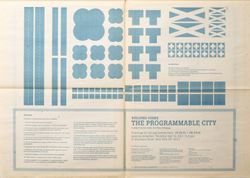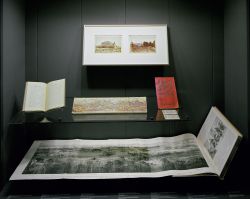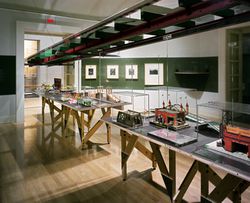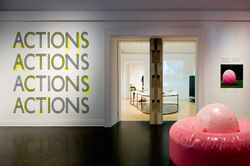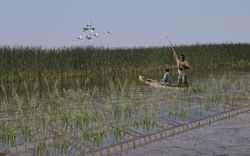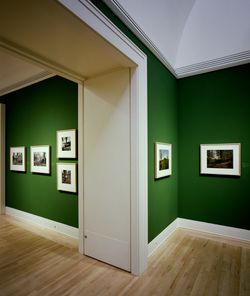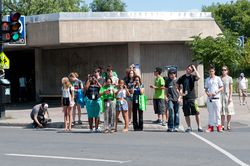photographs
DR2012:0012:155:002
Description:
Binder containing duplicates slides of photographs and photographic artworks taken in the following locations: - Montreal, 1956, 1964, 1972, 1975 (5 slides); - Italy, 1960-1961 (3 slides); - Turkey, 1961 (2 slides and 4 negatives); - New York City, room 202, P.S. 1 1979 (1 slide); - Canadian prairies, 1985 (11 slides, 3 slides appear to be duplicates); - Tel Aviv, 1993 (57 slides, 38 slides appear to be duplicates); - Jerusalem, 1994 (31 slides, 24 slides appear to be duplicates); - Paris, 1994-1995 (buildings) and 1998-1999 (trees) (45 slides, 26 slides appear to be duplicates); - Brussels, 1994-1995 (34 slides, 27 slides appear to be duplicates); - Maine, 2000-2001 (3 slides, 2 slides appear to be duplicates); - Rome, 2000-2001 (17 slides, 13 slides appear to be duplicates). Projects: - Parc des Buttes Chaumont, Paris, 1988; - Variations, rue Beranger, Paris, 1996-1997; - Variations, rue Charlot, Paris, 1996-1997; - Origins of a white city... no. 2, 1994-1995; - Origins of a white city... no. 3, 1994-1995; - Monuments: Zachariah's tomb, Kidron Valley, Jerusalem, 1993; - Tel Aviv series ... the white city revisited, 1993; - Grain elevators, Wellington, south of Lethbridge, 1985; - Milk River, Alberta, 1985; - House and store, Milk River, Alberta, 1985. Ring binder labelled: PHOTOG DUP SLIDES / 1
1956-2001
Photographs of various projects by Melvin Charney and reference photographs of artworks
Actions:
DR2012:0012:155:002
Description:
Binder containing duplicates slides of photographs and photographic artworks taken in the following locations: - Montreal, 1956, 1964, 1972, 1975 (5 slides); - Italy, 1960-1961 (3 slides); - Turkey, 1961 (2 slides and 4 negatives); - New York City, room 202, P.S. 1 1979 (1 slide); - Canadian prairies, 1985 (11 slides, 3 slides appear to be duplicates); - Tel Aviv, 1993 (57 slides, 38 slides appear to be duplicates); - Jerusalem, 1994 (31 slides, 24 slides appear to be duplicates); - Paris, 1994-1995 (buildings) and 1998-1999 (trees) (45 slides, 26 slides appear to be duplicates); - Brussels, 1994-1995 (34 slides, 27 slides appear to be duplicates); - Maine, 2000-2001 (3 slides, 2 slides appear to be duplicates); - Rome, 2000-2001 (17 slides, 13 slides appear to be duplicates). Projects: - Parc des Buttes Chaumont, Paris, 1988; - Variations, rue Beranger, Paris, 1996-1997; - Variations, rue Charlot, Paris, 1996-1997; - Origins of a white city... no. 2, 1994-1995; - Origins of a white city... no. 3, 1994-1995; - Monuments: Zachariah's tomb, Kidron Valley, Jerusalem, 1993; - Tel Aviv series ... the white city revisited, 1993; - Grain elevators, Wellington, south of Lethbridge, 1985; - Milk River, Alberta, 1985; - House and store, Milk River, Alberta, 1985. Ring binder labelled: PHOTOG DUP SLIDES / 1
photographs
1956-2001
The City Decoded
What if we played to re-imagine Montreal? After decoding the spatial policies linked to the planning of your city, it is your turn to rethink the urban fabric by combining houses, stores, parks, factories and corner stores. Montreal is transformed into a board game and its buildings and roads turned into game pieces. Noise management, sunlight, pollution and mixed-use(...)
The Other Architect
7 February 2016 to 21 February 2016
The City Decoded
Actions:
Description:
What if we played to re-imagine Montreal? After decoding the spatial policies linked to the planning of your city, it is your turn to rethink the urban fabric by combining houses, stores, parks, factories and corner stores. Montreal is transformed into a board game and its buildings and roads turned into game pieces. Noise management, sunlight, pollution and mixed-use(...)
The Other Architect
textual records
ARCH174239
Description:
Groupe comprend des esquisses, de la correspondance avec la Société du Vieux-Port de Montréal (S.V.P.M.), marché de services entre S.V.P.M. et Luc Laporte, architecte (12 nov. 1991 & 1er mars 1992), des documents de facturation à la S.V.P.M. & mesures de paiement, une résiliation du Marché de service (4 décembre 1991), des dessins et données techniques relatifs à la fabrication des lampadaires, de la correspondance avec l'agence de Cardinal & Hardy, des documents relatifs à la plate-forme du dôme, des exemples de mobiliers de parcs, dessins de précision du détail de parapet (20 nov. 1992) et estimation des coûts du travail d'architecture.
1991-1993
Contrats, correspondance avec client et architectes, documents financiers, croquis et dessins pour les lampadaires, et documents de référence, Pavillon du Bassin Bonsecours, Montréal, Québec
Actions:
ARCH174239
Description:
Groupe comprend des esquisses, de la correspondance avec la Société du Vieux-Port de Montréal (S.V.P.M.), marché de services entre S.V.P.M. et Luc Laporte, architecte (12 nov. 1991 & 1er mars 1992), des documents de facturation à la S.V.P.M. & mesures de paiement, une résiliation du Marché de service (4 décembre 1991), des dessins et données techniques relatifs à la fabrication des lampadaires, de la correspondance avec l'agence de Cardinal & Hardy, des documents relatifs à la plate-forme du dôme, des exemples de mobiliers de parcs, dessins de précision du détail de parapet (20 nov. 1992) et estimation des coûts du travail d'architecture.
textual records
1991-1993
Civic Visions, World's Fairs
The dazzling energies of world’s fairs are well known —millions of visitors, encyclopaedic displays of goods and ideas, fantastic settings of pavilions and exhibition halls—but the sites that gather the exposition experience into a spatial unity are often overlooked. Civic Visions, World’s Fairs looks at the contribution of site planning to the history of international(...)
Hall cases
17 March 1993 to 1 August 1993
Civic Visions, World's Fairs
Actions:
Description:
The dazzling energies of world’s fairs are well known —millions of visitors, encyclopaedic displays of goods and ideas, fantastic settings of pavilions and exhibition halls—but the sites that gather the exposition experience into a spatial unity are often overlooked. Civic Visions, World’s Fairs looks at the contribution of site planning to the history of international(...)
Hall cases
Toys and Transport
Every new transportation link and every change in systems of urban mobility introduces new infrastructure to the urban landscape: massive cuts enabling railway tracks to converge at a terminal or junction; wide railyards that service suburban and metropolitan transit systems; the proliferation of bridges, ramps, elevated highways, freeway cuts, parking lots, and even(...)
Octagonal gallery
15 November 2000 to 1 April 2001
Toys and Transport
Actions:
Description:
Every new transportation link and every change in systems of urban mobility introduces new infrastructure to the urban landscape: massive cuts enabling railway tracks to converge at a terminal or junction; wide railyards that service suburban and metropolitan transit systems; the proliferation of bridges, ramps, elevated highways, freeway cuts, parking lots, and even(...)
Octagonal gallery
Sub-series
CI001.S1.D3
Description:
The urban and public architecture of Hubert Rohault de Fleury is insightful concerning both the stylistic directions of utilitarian architecture in France and the structure and role of the government architectural services (1) in the Empire and the Restoration. The drawings in the CCA collection depict built and unbuilt projects undertaken in the context of Hubert's positions in the government architectural services as well as private commissions. Hubert's principal official positions related to three branches of the French government: the Préfecture de la police, the Conseil général des hospices and the Conseil des Bâtiments Civils, a "division" of the Ministère de l'interieur. Hubert's work for the Préfecture de la police (which was also responsible for the gendarmerie and the sapeurs-pompiers barracks) is represented in the CCA collection by projects for four gendarmerie barracks (1821-1830) and alterations to the Préfecture de la Police (1833 ?) and nearby prison in Paris (1819)(DR1974:0002:016:001-070 / DR1974:0002:011:001-089 and DR1974:0002: 015:001-070). The drawings in these albums emphasize the planning (or re-arrangement) of the interior spaces. The album for the Préfecture de la police also includes record drawings for prisons in England and France as background material for Hubert's work and/or related to reports for the Conseil des Bâtiments Civils, which had an active role in the design of prisons throughout France during the early years of the nineteenth century (2). Although the CCA collection has no drawings directly related to Hubert's position as the architecte des hospices (3), drawings and prints are included for his earlier ideal hospitals (ca. 1810) (DR1974:0002:008:001-077). These projects continue the late 17th and 18th century tradition of monumental geometrically laid-out ideal hospitals. This album also contains prints and drawings of medical buildings by other architects (probably reference material), and drawings of Hubert's unexecuted proposal for the re-development of the École de médecine (Paris) and the surrounding buildings and urban spaces. Hubert was the architecte de l'École de medicine (4); a position that probably related to his work for the Ministère d'Interieur, which would have been responsible for this building. In general, Hubert's role and responsibilities within the Ministère de l'interieur and the associated Conseil de Bâtiment Civils (especially prior to his appointment to the position of inspecteur gènèral in 1830) are the least clear of his government positions. In addition to the École de medicine album, two other albums contain projects relating to the Ministère de l'Interieur: two proposals for Place Louis XV commissioned by the Ministre de l'interieur, Duc Decazes in 1821 (DR1974:0002:037:001-031), and drawings for the conversion or renovation of several Parisian hôtel particuliers (probably between 1810 and ca. 1820) including those used by the Ministère de l'interieur, Ministère de la Guerre and the Ministère des affaires étrangères (DR1974:0002;011:001-089). On other government commission of significance is represented in the CCA collection. In 1819, Hubert Rohault de Fleury in collaboration with Etienne Hyppolite Godde was commissioned to direct the restoration of the Thermes de Julien located under the Hôtel de Cluny. The CCA collection includes several letters and drawings, and a report related to this commission (DR1974:0002 :037:001-031). Hubert's private urban projects, mostly commissioned by private entrepreneurs or societies, were concerned with the expansion of the infrastructure of Paris and the surrounding communities as well as, to some extent, larger issues of urban development. One album contains projects dating from between 1819 and 1836 related horses - an essential part of 19th century urban life (5): a stud-farm (Haras de Madrid, Bois de Boulogne), an auction house and an infirmary (Clos St. Charles, Clos d'équarrissage, fôret de Bondy) and three slaughterhouses (Plaine de Grenelle, an unnamed project and La Villete (6))(DR1974:0002:014:001-104). These album also includes developmental studies for a new quartier of Paris - Nouveau Quartier Poissonière (the site of today's 10e arrondissement). A second album (ca. 1825) includes designs for a "maison de blanchisseur", an "entrepot de vins" with adjacent "guingette" and designs for structures at Parc de Clichy - a reservoir, a washhouse and a manège (DR1974:0002:009:001-079) (7). The drawings in these albums are particularly informative regarding the materials, structures and mechanical systems utilized. As with most of his government commissions, for these buildings, Hubert adopted a sparse architectural syntax of pared-down classical motifs and regimented plans grounded in the ideas of Durand and commonly used in utilitarian buildings during the 19th century. (1) These are discussed in some detail in Chapter 2 of David Van Zanten, 'Building Paris' (Cambridge: Cambridge University Press, 1994). (2) Van Zanten, 'Building Paris', 51-52. (3) The Cabinet des Estampes at the Musée Carnavalet in Paris has drawings related to Hubert's work for the Conseil général des hospices. (4) Evidence of this position is based on inscriptions on drawings in album, DR1974:0002:008:001-77. (5) Bergdoll, 4. (6) The La Villete slaughterhouse was designed by Charles Rohault de Fleury. (7) The source(s) of these commissions is unknown.
1754-1875
Public and Urban architecture
CI001.S1.D3
Description:
The urban and public architecture of Hubert Rohault de Fleury is insightful concerning both the stylistic directions of utilitarian architecture in France and the structure and role of the government architectural services (1) in the Empire and the Restoration. The drawings in the CCA collection depict built and unbuilt projects undertaken in the context of Hubert's positions in the government architectural services as well as private commissions. Hubert's principal official positions related to three branches of the French government: the Préfecture de la police, the Conseil général des hospices and the Conseil des Bâtiments Civils, a "division" of the Ministère de l'interieur. Hubert's work for the Préfecture de la police (which was also responsible for the gendarmerie and the sapeurs-pompiers barracks) is represented in the CCA collection by projects for four gendarmerie barracks (1821-1830) and alterations to the Préfecture de la Police (1833 ?) and nearby prison in Paris (1819)(DR1974:0002:016:001-070 / DR1974:0002:011:001-089 and DR1974:0002: 015:001-070). The drawings in these albums emphasize the planning (or re-arrangement) of the interior spaces. The album for the Préfecture de la police also includes record drawings for prisons in England and France as background material for Hubert's work and/or related to reports for the Conseil des Bâtiments Civils, which had an active role in the design of prisons throughout France during the early years of the nineteenth century (2). Although the CCA collection has no drawings directly related to Hubert's position as the architecte des hospices (3), drawings and prints are included for his earlier ideal hospitals (ca. 1810) (DR1974:0002:008:001-077). These projects continue the late 17th and 18th century tradition of monumental geometrically laid-out ideal hospitals. This album also contains prints and drawings of medical buildings by other architects (probably reference material), and drawings of Hubert's unexecuted proposal for the re-development of the École de médecine (Paris) and the surrounding buildings and urban spaces. Hubert was the architecte de l'École de medicine (4); a position that probably related to his work for the Ministère d'Interieur, which would have been responsible for this building. In general, Hubert's role and responsibilities within the Ministère de l'interieur and the associated Conseil de Bâtiment Civils (especially prior to his appointment to the position of inspecteur gènèral in 1830) are the least clear of his government positions. In addition to the École de medicine album, two other albums contain projects relating to the Ministère de l'Interieur: two proposals for Place Louis XV commissioned by the Ministre de l'interieur, Duc Decazes in 1821 (DR1974:0002:037:001-031), and drawings for the conversion or renovation of several Parisian hôtel particuliers (probably between 1810 and ca. 1820) including those used by the Ministère de l'interieur, Ministère de la Guerre and the Ministère des affaires étrangères (DR1974:0002;011:001-089). On other government commission of significance is represented in the CCA collection. In 1819, Hubert Rohault de Fleury in collaboration with Etienne Hyppolite Godde was commissioned to direct the restoration of the Thermes de Julien located under the Hôtel de Cluny. The CCA collection includes several letters and drawings, and a report related to this commission (DR1974:0002 :037:001-031). Hubert's private urban projects, mostly commissioned by private entrepreneurs or societies, were concerned with the expansion of the infrastructure of Paris and the surrounding communities as well as, to some extent, larger issues of urban development. One album contains projects dating from between 1819 and 1836 related horses - an essential part of 19th century urban life (5): a stud-farm (Haras de Madrid, Bois de Boulogne), an auction house and an infirmary (Clos St. Charles, Clos d'équarrissage, fôret de Bondy) and three slaughterhouses (Plaine de Grenelle, an unnamed project and La Villete (6))(DR1974:0002:014:001-104). These album also includes developmental studies for a new quartier of Paris - Nouveau Quartier Poissonière (the site of today's 10e arrondissement). A second album (ca. 1825) includes designs for a "maison de blanchisseur", an "entrepot de vins" with adjacent "guingette" and designs for structures at Parc de Clichy - a reservoir, a washhouse and a manège (DR1974:0002:009:001-079) (7). The drawings in these albums are particularly informative regarding the materials, structures and mechanical systems utilized. As with most of his government commissions, for these buildings, Hubert adopted a sparse architectural syntax of pared-down classical motifs and regimented plans grounded in the ideas of Durand and commonly used in utilitarian buildings during the 19th century. (1) These are discussed in some detail in Chapter 2 of David Van Zanten, 'Building Paris' (Cambridge: Cambridge University Press, 1994). (2) Van Zanten, 'Building Paris', 51-52. (3) The Cabinet des Estampes at the Musée Carnavalet in Paris has drawings related to Hubert's work for the Conseil général des hospices. (4) Evidence of this position is based on inscriptions on drawings in album, DR1974:0002:008:001-77. (5) Bergdoll, 4. (6) The La Villete slaughterhouse was designed by Charles Rohault de Fleury. (7) The source(s) of these commissions is unknown.
File 3
1754-1875
Seemingly common activities such as walking, playing, recycling, and gardening are pushed beyond their usual definition by the international architects, artists, and collectives featured in the exhibition. Their actions push against accepted norms of behaviour in cities, at times even challenging legal limitations. The individuals and groups employ a range of approaches(...)
Main galleries
26 November 2008 to 19 April 2009
Actions: What You Can Do With the City
Actions:
Description:
Seemingly common activities such as walking, playing, recycling, and gardening are pushed beyond their usual definition by the international architects, artists, and collectives featured in the exhibition. Their actions push against accepted norms of behaviour in cities, at times even challenging legal limitations. The individuals and groups employ a range of approaches(...)
Main galleries
The St. Peter’s Indian Band (now Peguis First Nation) was forcibly removed from their original lands at Netley-Libau Marsh beginning in 1908, after an illegal surrender vote took place. Since then, the health of the area that was once the Peguis’s home has declined due to intense annual flooding and ice jams; the appearance of invasive species such as purple loosestrife,(...)
online Keyword(s):
Indigenous-led design, fellow, Peguis First Nation, land rehabilitation
27 April 2023, 6:00 to 7:30 p.m.
Peguis First Nation and the Netley-Libau Marsh: Documenting Indigenous Land Use and Occupancy at the Mouth of Lake Winnipeg
Actions:
Description:
The St. Peter’s Indian Band (now Peguis First Nation) was forcibly removed from their original lands at Netley-Libau Marsh beginning in 1908, after an illegal surrender vote took place. Since then, the health of the area that was once the Peguis’s home has declined due to intense annual flooding and ice jams; the appearance of invasive species such as purple loosestrife,(...)
online Keyword(s):
Indigenous-led design, fellow, Peguis First Nation, land rehabilitation
Through a commission from the CCA, three contemporary photographers spent six years interpreting the work of Frederick Law Olmsted (1822–1903), North America’s most important landscape architect. *Viewing Olmsted: Photographs by Robert Burley, Lee Friedlander, and Geoffrey James* presents 155 photographs from this commission to offer visitors an opportunity to understand(...)
Main galleries
16 October 1996 to 2 February 1997
Viewing Olmsted: Photographs by Robert Burley, Lee Friedlander, and Geoffrey James
Actions:
Description:
Through a commission from the CCA, three contemporary photographers spent six years interpreting the work of Frederick Law Olmsted (1822–1903), North America’s most important landscape architect. *Viewing Olmsted: Photographs by Robert Burley, Lee Friedlander, and Geoffrey James* presents 155 photographs from this commission to offer visitors an opportunity to understand(...)
Main galleries
The Unschool
What could a school be? For a week over summer 2012, students of The Unschool explored the spaces in and around schools and pushed the limits of the camera as a social instrument with guest curator Monica Nouwens. Participants compared how people live in schools and cities, and how design can encourage and limit behaviours, relationships, and activities. “Could(...)
30 July 2012 to 3 August 2012
The Unschool
Actions:
Description:
What could a school be? For a week over summer 2012, students of The Unschool explored the spaces in and around schools and pushed the limits of the camera as a social instrument with guest curator Monica Nouwens. Participants compared how people live in schools and cities, and how design can encourage and limit behaviours, relationships, and activities. “Could(...)
